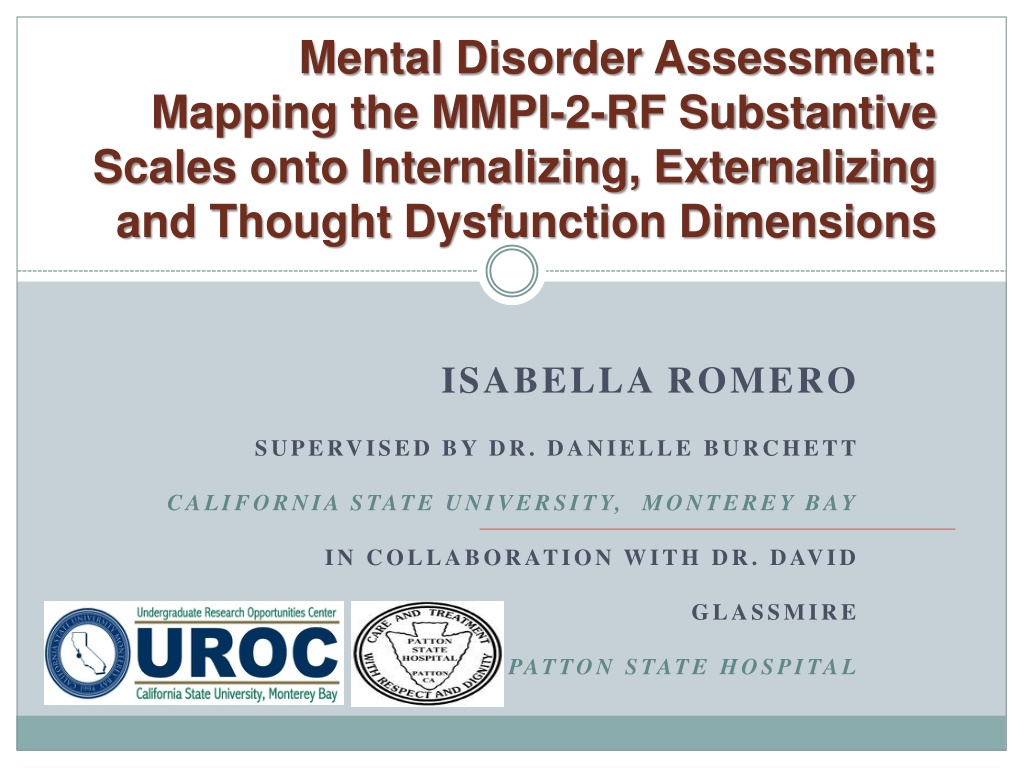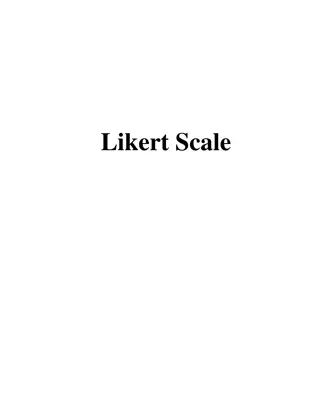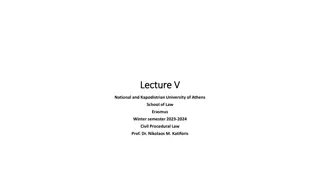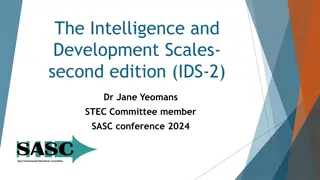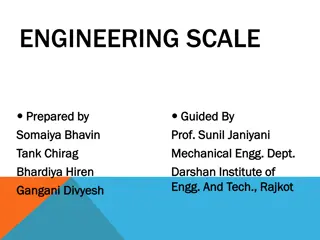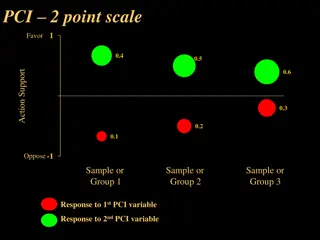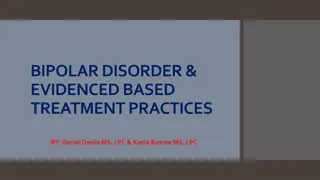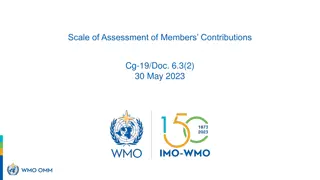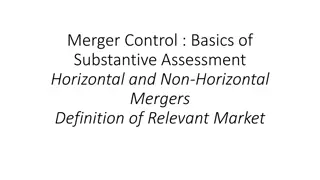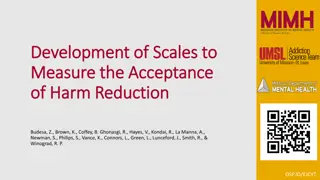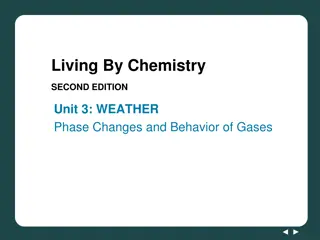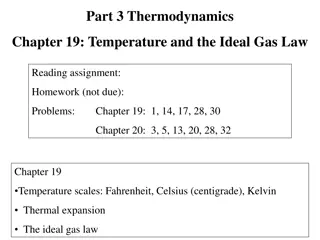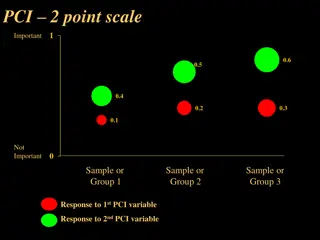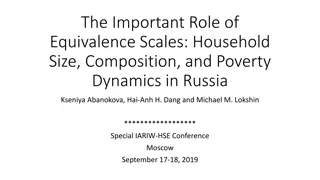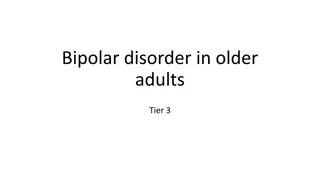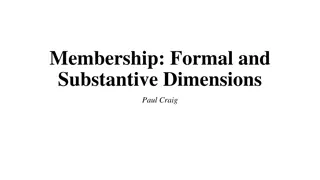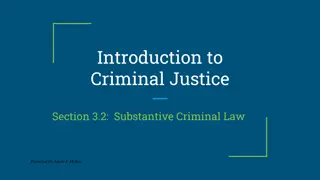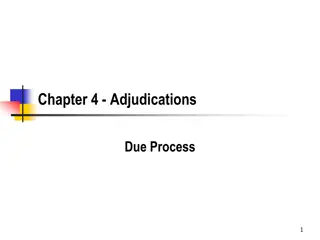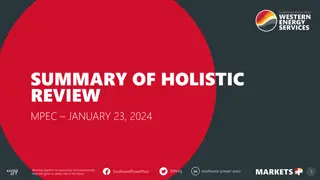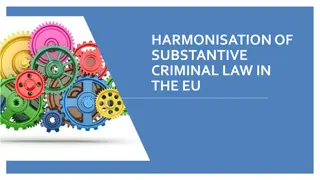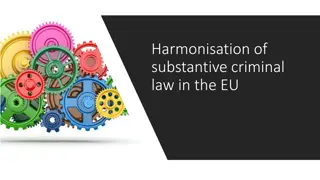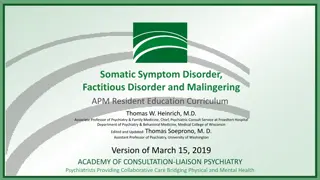Understanding the MMPI-2-RF Substantive Scales for Mental Disorder Assessment
This research explores mapping the MMPI-2-RF substantive scales onto internalizing, externalizing, and thought dysfunction dimensions in mental health assessment. The study emphasizes the importance of validating assessments for accurate clinical pictures and effective treatment planning. It delves into the model of psychopathology, the MMPI-2-RF structure, and technical manual details for emotional, behavioral, and thought dysfunction categories.
Download Presentation

Please find below an Image/Link to download the presentation.
The content on the website is provided AS IS for your information and personal use only. It may not be sold, licensed, or shared on other websites without obtaining consent from the author. Download presentation by click this link. If you encounter any issues during the download, it is possible that the publisher has removed the file from their server.
E N D
Presentation Transcript
Mental Disorder Assessment: Mapping the MMPI-2-RF Substantive Scales onto Internalizing, Externalizing and Thought Dysfunction Dimensions ISABELLA ROMERO SUPERVISED BY DR. DANIELLE BURCHETT CALIFORNIA STATE UNIVERSITY, MONTEREY BAY IN COLLABORATION WITH DR. DAVID GLASSMIRE PATTON STATE HOSPITAL
Why Validate Assessments? Tools which inform important processes for mental health practitioners Give clinical picture Must be accurate to inform effective treatment plan Diagnostic construct validity http://www.fairfaxmentalhealth.com/wp- content/uploads/2014/08/psychologists-prescribing-medications.jpg http://www.californiapainmedicinecenter.com/wp- content/uploads/2015/05/psychotherapy-los-angeles.jpg
Model of Psychopathology Three Factor Model of Psychopathology: The internalizing and externalizing dimensions, have received the most empirical support within general populations (Eaton, et al., 2012, Krueger, 1999) Thought Dysfunction Internalizing Externalizing Schizophrenia Hyperactivity Disorders (?) Substance Depression Personality Antisocial Attention- Somatic Anxiety Mania Abuse
MMPI-2-RF Minnesota Multiphasic Personality Inventory-2- Restructured Form (MMPI-2-RF, Ben-Porath & Tellegen, 2008/2011) Emotional Internalizing Dysfunction Dysfunction Behavioral Externalizing Thought Dysfunction
MMPI-2-RF Technical Manual of the MMPI-2-RF (Tellegen & Ben- Porath, 2008/2011) Emotional/ Internalizing Dysfunction EID RC7 RC1 Somatic Complaints RCd RC2 Low Positive Emotions Dysfunctional Negative Emotions Demoralization Somatic SP Scales: MLS, HPC Internalizing SP Scales: eg. SUI, HLP, AXY Interpersonal SP Scales: eg: SHY,SAV Low AES & MEC: Aesthetic-Literary Interests & Mechanical Interests Negative Emotionality/ Neuroticism -r Introversion-r
MMPI-2-RF BXD Behavioral Externalizing Dysfunction RC4 Antisocial Behavior RC9 Hypomanic Activation Interpersonal SP Scales: FML: Family Problems Internalizing SP Scales: ANP: Anger Proneness Externalizing SP Scales: JCP, SUB AGG-r DISC-r Disconstraint Aggressiveness
MMPI-2-RF THD Thought Dysfunction RC6 Ideas of Persecution RC8 Aberrant Experiences PSYC-r Psychoticism
Current Study: Research Question Past MMPI-2-RF Research: Compared mean scores for specific diagnostic groups (eg. Bipolar disorder, v. schizophrenia, Sellbom, et al., 2012) Current Study: Does the MMPI-2-RF distinguish between forensic inpatients with and without 1. Internalizing Disorders 2. Externalizing Disorders 3. Thought Dysfunction Disorders ?
Method Participants 641 forensic inpatients, Males (72.1 %) Mean Age = 40.96 years Yes (n =320) Internalizing No (n =321) Total = 1,110 Yes (n =469) Externalizing No (n = 172) Valid = 641 Yes (n = 562) Thought No (n = 69)
Hypotheses Scales Internalizing Externalizing Thought Dysfunction Higher- Order Scales EID BXD THD Restructured Clinical Scales RCd, RC1, RC2, RC,7 RC4 & RC9 RC6 & RC8 Specific Problems Scales Internalizing, Somatic, Intrapersonal Low AES & MEC ANP, Externalizing Scales, FML Interest Scales Personality Pathology-5 Scales NEGE-r & INTR-r DISC-r & AGG-r PSYC-r
Method: Statistical Analyses *Independent Samples t-test: Comparing means of independent samples Hedges' g values: Comparing size of difference between two means Small: .20-.49 Medium: .50-.79 Large: .80+ M1 M2 Cohen (1988)
Results: Internalizing Diagnosis MMPI-2-RF Scales Yes (n = 320) No (n = 321) g Higher-Order Scales M SD M SD EID: Emotional/ Internalizing Dysfunction 53.9 12.6 49.3 10.5 0.39* Restructured Clinical Scales RCd: Demoralization 55.7 11.9 51.6 10.7 0.35* RC1: Somatic Complaints 55.7 11.0 51.7 10.6 0.33* RC2: Low Positive Emotions 53.8 13.8 50.9 11.6 0.22* RC7: Dysfunctional Negative Emotions 51.5 11.2 47.4 10.7 0.37* Somatic Specific Problems Scales MLS: Malaise 53.92 52.98 15.4 11.92 52.8 49.66 10.7 9.41 0.29* 0.31* GIC: Gastrointestinal Complaints 51.88 10.52 50.36 9.48 0.15* HPC: Head Pan Complaints 59.91 12.57 55.45 12.58 0.35* NUC: Neurological Complaints 54.77 12.95 51.57 11.49 0.26* COG: Cognitive Complaints Interest Scales 50.08 10.04 49.97 11.24 0.01 AES: Aesthetic-Literary Interests 53.81 10.70 56.05 10.68 -0.21* MEC: Mechanical Interests
Yes (n = 320) No (n = 321) g Internalizing SP Scales M SD M SD 53.92 15.39 49.98 10.59 0.30* SUI: Suicidal/Death Ideation 52.52 13.63 49.36 11.27 0.25* HLP: Helplessness 52.96 11.50 49.46 9.69 0.33* SFD: Self-Doubt 53.18 10.60 50.46 10.83 0.25* NFC: Inefficacy 51.13 11.15 47.70 9.59 0.33* STW: Stress and Worry 55.50 14.11 52.15 12.88 0.25* AXY: Anxiety 50.50 10.12 47.13 8.91 0.35* ANP: Anger Proneness 55.75 13.47 52.43 11.64 0.26* BRF: Behavior restricting Fears 51.71 9.32 49.11 9.20 0.28* MSF: Multiple Specific Fears Interpersonal Specific Problems Scales 48.43 10.43 48.52 9.72 -0.01 IPP: Interpersonal Problems 50.66 10.85 49.34 10.94 0.12 SAV: Social Avoidance 49.36 9.42 47.69 8.44 0.19* SHY: Shyness 54.46 12.66 53.40 12.08 0.09 DSF: Disafiliativeness Personality Pathology- 5 Scales 52.51 10.78 48.28 10.30 0.40* NEGE-r: Negative Emotionality/Neuroticism-Revised 52.13 11.73 51.42 11.68 0.06 INTR-r: Introversion-Revised
Results: Externalizing Diagnosis MMPI-2-RF Scales Yes (n = 469) No (n = 172) g Higher-Order Scales M SD 10.63 M SD 10.39 58.60 53.72 0.46* BXD: Behavioral Externalizing Dysfunction Restructured Clinical Scales 62.13 11.43 56.70 10.90 0.48* RC4: Antisocial Behaviors 48.03 10.86 46.95 10.99 0.10 RC9: Hypomanic Activation Internalizing Specific Problems Scale 49.19 9.83 47.78 9.18 0.15 ANP: Anger Proneness Externalizing Specific Problems Scales 61.34 13.11 55.60 12.64 0.44* JCP: Juvenile Conduct Problems 57.11 10.35 50.49 9.96 0.65* SUB; Substance Abuse 49.78 10.97 48.20 9.95 0.15* AGG: Aggression 47.36 12.17 46.03 11.55 0.11 ACT: Activation Interpersonal Scales 51.59 12.10 50.72 12.45 0.07 FML: Family Problems Personality Pathology-5 Scales 51.48 10.43 51.13 9.48 0.03 AGGR-r: Aggressiveness-Revised 57.07 10.15 52.78 9.75 0.43* DISC-R: Disconstraint-Revised
Results: Thought Dysfunction Diagnosis MMPI-2-RF Scales Yes (n = 572) No (n = 69) g Higher-Order Scales M SD M SD 58.05 15.14 53.96 14.09 0.27* THD: Thought Dysfunction Restructured Clinical Scales 61.72 15.83 60.59 15.75 0.07 RC6: Ideas of Persecution 55.19 12.57 52.26 11.90 0.23* RC8: Aberrant Experiences Personality Pathology-5 Scales 56.22 14.91 52.94 13.65 0.22* PSYC-r: Psychoticism-Revised
Discussion Key Findings: Higher-Order (H-O) scales demonstrated strong construct validity Somatic problems are significantly associated with Internalizing domain Interestingly, Ideas of Persecution scores were similar across groups; may be result of controlled settings (Morgan, Rozycki, & Wilson, 2004) Strengths: High base rates of severe mental illness across all three domains Limitations & Future Directions Overlapping vs. pure diagnostic groups VS.
Acknowledgements & References Eaton, N. R., Krueger, R. F., Markon, K. E., Keyes, K. M., Skodol, A. E., Wall, M., Grant, B. F. (2012). The structure and predictive validity of the internalizing disorders. Journal of Abnormal Psychology, 122(1), 86 92. doi: 10.1037/a0029598 Thanks to the following for making this study possible: University of Minnesota Press, which supported data collection Dr. Glassmire of Patton State Hospital Dr. Danielle Burchett CSUMB Undergraduate Research Opportunities Center (UROC) Krueger, R. F. (1999). The structure of common mental disorders. Archives of General Psychiatry, 56(10), 921 926. doi: 10.1001/archpsyc.56.10.921 Tellegen, A., & Ben-Porath, Y. S. (2008/2011). MMPI-2-RF (Minnesota Multiphasic Personality Inventory-2 Restructured Form): Technical manual. Minneapolis, MN: University of Minnesota Press. Weinborn, M., Orr, T., Woods, S. P., Conover, E., & Feix, J. (2003). A validation of the Test of Memory Malingering in a forensic psychiatric setting. Journal of Clinical and Experimental Neuropsychology, 25(7), 979- 990.
